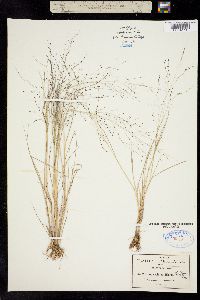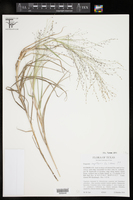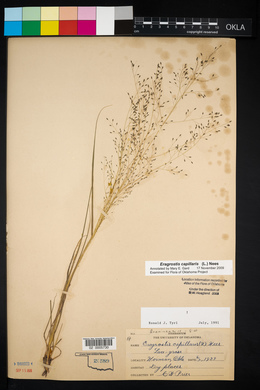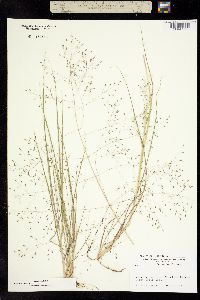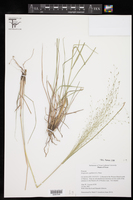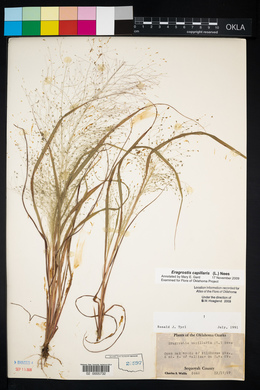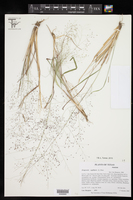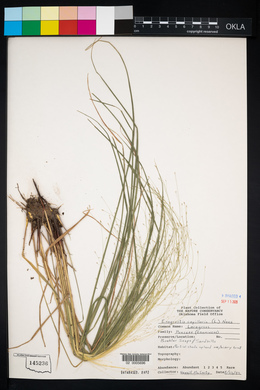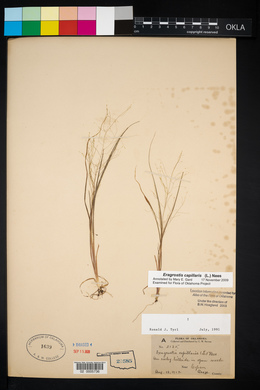Eragrostis capillaris
|
|
|
|
Family: Poaceae
Lace Grass, more...Lacegrass
[Aira capillacea Lam., moreEragrostis pilosa var. capillaris (L.) Kuntze] |
Plants annual; tufted, without innovations, without glands. Culms (15)20-50(60) cm, erect, glabrous, often shiny below the nodes. Sheaths pilose along the margins, apices hirsute, hairs to 7 mm; ligules 0.2-0.5 mm, ciliate; blades (6)8-20(30) cm long, (1)2-5 mm wide, flat, abaxial surfaces smooth, glabrous, adaxial surfaces scabridulous, with long scattered hairs. Panicles (10)15-45(55) cm long, (7)10-25 cm wide, to 2/3 the height of the plants, elliptic to ovate, open, rachises without glandular pits; primary branches (2)5-15 cm, diverging 20-90° from the rachises, capillary, naked basally; pulvini glabrous; pedicels (4)5-25 mm, divergent, scabridulous. Spikelets (1.4)2-5 mm long, 1-1.3(1.4) mm wide, ovate to lanceolate, plumbeous, occasionally reddish-purple, with 2-5(7) florets; disarticulation acropetal, paleas persistent. Glumes narrowly lanceolate to lanceolate, hyaline; lower glumes 1-1.2 mm, narrower than the upper glumes; upper glumes 1.2-1.4 mm; lemmas 1.2-1.7 mm, broadly ovate, membranous, keels scabridulous, lateral veins inconspicuous, apices acute; paleas 1.2-1.6 mm, hyaline, keels almost smooth to scabrous, scabridities to 0.1 mm, apices acute to obtuse; anthers 3, 0.2-0.3 mm, reddish-brown. Caryopses 0.4-0.7 mm, ovoid to rectangular-prismatic, adaxial surfaces deeply grooved, striate, bases reddish-brown, distal 2/3 opaque. 2n = 50, 100. Eragrostis capillaris is native to the eastern portion of the Flora region. It grows in open, dry, sandy riverbanks, floodplains, rocky roadsides, and gravel pits, at 150-1500 m, usually in association with Pinus, Quercus, Carrya, and Liquidambar styraciflua. Its range extends into northeastern Mexico.
Eragrostis capillaris resembles E. frankii, but differs in its lack of glandular pits, deeply grooved caryopses, longer pedicels, pilose sheath margins, and larger panicles. The two species are sympatric over much of the eastern United States. Annual tufted, non-glandular herb 15 cm - 1.15 m tall Leaves: with open sheaths having 7 mm long stiff hairs at the tip and minute hairs along the margins, and 0.2 - 0.5 mm long ligules that have margins lined with hairs. The blades are 6 - 30 cm long, 1 - 5 mm wide, flat, hairless and smooth beneath, minutely roughened and sparsely long-haired above. Inflorescence: terminal, branched (panicle), open, rising above the upper leaves, 10 cm - 0.55 m long, 7 - 25 cm wide, elliptic to egg-shaped, with primary branches 2 - 15 cm long and naked near the base. Fruit: a caryopsis, reddish brown with the upper two-thirds opaque, 0.4 - 0.7 mm long, egg-shaped to rectangle-faced (prism-like), longitudinally lined with a deep groove on one side. Culm: 15 cm - 0.6 m long, erect, hairless, usually shiny beneath the nodes. Spikelets: on a minutely rough stalk 4 - 25 mm long, grayish to reddish purple, 1.4 - 5 mm long, 1 - 1.4 mm wide, egg-shaped to lance-shaped, laterally compressed. Glumes: transparent, lance-shaped, single-veined, neither lobed nor awned. The lower glume is 1 - 1.2 mm long and narrower than the upper glume, and the upper glume is 1.2 - 1.4 mm long. Florets: two to seven per spikelet, with three reddish brown, 0.2 - 0.3 mm long anthers. Lemma: 1.2 - 1.7 mm long, broad egg-shaped with a pointed tip, membrane-like, usualy hairless, with inconspicuous lateral veins and a minutely rough longitudinal ridge. Palea: transparent, 1.2 - 1.6 mm long, with a pointed to blunt tip and a rough to nearly smooth longitudinal ridge. Similar species: Eragrostis capillaris, Eragrostis frankii, and Eragrostis mexicana are annuals with grooved caryopses (E. frankii is not always grooved). Eragrostis frankii usually has glands on the culm and inflorescence branches, the inflorescences (4 - 20 cm) and spikelet stalks (1.5 - 5 mm) are shorter, the two or three anthers are purple, and the caryopses are sometimes shallowly grooved. Eragrostis mexicana sometimes has glands on the culm and leaves, the spikelets are longer (4 - 11 mm) and have more florets (five to fifteen), and the three anthers are purplish. Flowering: early July to early September Habitat and ecology: Local in waste ground, weedy areas, open woodlands, and along railroads. Occurence in the Chicago region: native Etymology: Eragrostis is derived from the name of the Greek god of love, Eros, and agrostis, meaning grass. Capillaris means hair-like. Author: The Morton Arboretum Tufted, erect or ascending annual 2-5 dm; lvs 2-
4 mm wide; infl large and diffusely branched, often two-thirds the height of the whole shoot, with
slender branches and elongate, capillary pedicels; spikelets 2-3 mm, 2-5-fld; first glume 0.9-1.5 mm, the second 1.1-1.4 mm; lemmas 1.2-1.6 mm, individually deciduous from the rachilla, on which the paleas persist; grain 0.6-0.7 mm, with a groove its entire length on one side; 2n=100. Open woods and dry soil; Me. to Wis., s. to Ga. and Tex. Gleason, Henry A. & Cronquist, Arthur J. 1991. Manual of vascular plants of northeastern United States and adjacent Canada. lxxv + 910 pp. ©The New York Botanical Garden. All rights reserved. Used by permission. From Flora of Indiana (1940) by Charles C. Deam This is an infrequent grass of southern Indiana which is found in poor soil, mostly on the open crests and slopes of black oak and black oak-white oak ridges. ...... Indiana Coefficient of Conservatism: C = 5 Wetland Indicator Status: N/A |




























